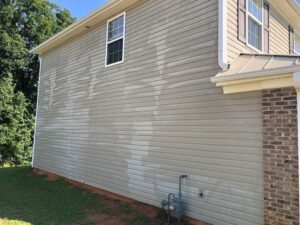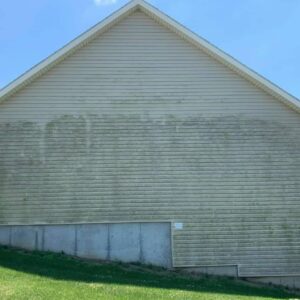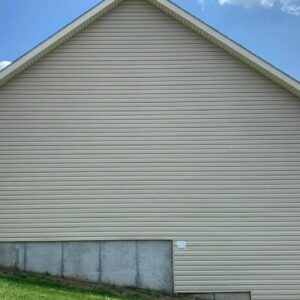
Pressure Washing Damage
Pressure washing your home can lead to water intrusion, property damage, and voided warranties. It can be very appealing to pressure wash your home when you walk outside and see green or brown organic growth on the shaded side of your home or dirt stains around the bottom or roadside. Pressure washing can effectively remove the organic growth and some of the surface dirt. It will not fully remove the dirt stains due to their bond with the substrate, your siding, brick, or stone. Although it is effective at some of this removal it is not a safe way to do this. The pressure coming out of a pressure washer is far more than what the materials used in traditional construction are designed to handle. This amount of pressure can damage the building materials and will void your warranty. Beyond that if you have siding, this force can drive water in behind your siding and cause it to be trapped. Further cause for concern, if you have an older exterior material that has been exposed to ultraviolet rays it has most likely began to oxidize. This oxidation will present itself as a discoloration of the material and or a chalky film on top that will wipe off on you finger when you run your finger across the surface. High pressure can disturb this oxidation layer and if not fully removed across the entirety will leave stripes on the surface that appear as clean and unclean areas.
So, what should you do? Professionals have the proper processes in place and utilize low pressure cleaning methods commonly referred to as soft washing to perform a proper house wash. A pressure washer may be used to apply the cleaning solutions or to rinse the surface with, but proper sizing of application equipment will keep the pressure low at the surface of the substrate. There are a multitude of types of solutions to use for varying types of stains or substrates being cleaned while performing soft washing. They all work on the same essential principles. Emulsifying the stain into a water solution by using a proper chemical/soap to breakdown the stain and cause it to release its bond to the surface. This is then flushed with water through a soft rinse process removing it from the surface before the solution can dry on the surface. A properly executed soft wash will effectively remove the vast majority of stains and will not disturb any oxidation on the surface thus mitigating the concern for tiger striping.
The chemicals or soaps used in a soft wash process must be carefully selected to properly emulsify the stain without damaging the substrate. Some areas will require being cleaned in multiple stages to remove different stains using different processes. Understanding which chemicals to use, how to use them, safety precautions to take for people, vegetation, animals, and property are all things that professionals are trained to take into consideration when performing a house wash. Oxidation can also be addressed through a restoration process after the structure has been cleaned utilizing specialized chemicals and processes this is not a part of standard house washing. Contact Wiseman Washing today for your free quote or consultation.

Before Soft Wash

After Softwash


